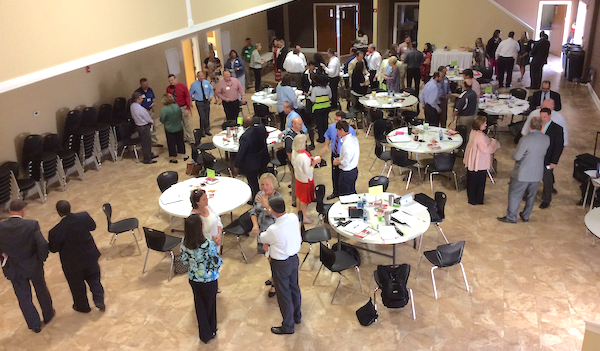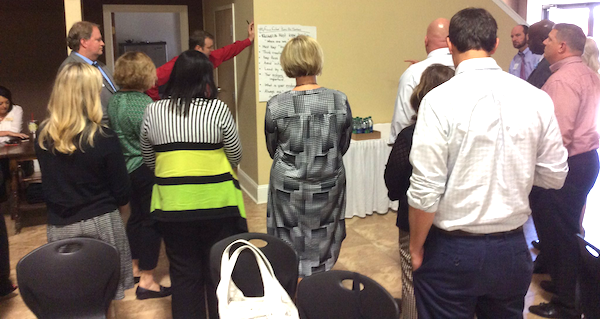Excerpted with permission from High-Payoff Strategies: How Education Leaders Get Results (Jossey-Bass/Wiley, 2016), our Key Leaders Network study book for 2016-17.
 By Jody Spiro
By Jody Spiro
Director of Education Leadership
Wallace Foundation
An education leader’s job can be overwhelming, but it doesn’t have to be! What we learn from research and successful leaders is that spending time on high-payoff strategies is the best way to get the biggest bang for the buck.
There are so many things to get done; it is of utmost importance to make distinctions between what needs to be done personally by the leader and what can be done by others.
Educators are often bad at making these distinctions among their plentiful tasks—they’re all important to the functioning of the school or district, right? Indeed, they are, but the leader does not have to—and should not—do them all personally.
An education leader is not a soloist but rather the conductor of an orchestra in which talented professionals contribute varied instruments and skills. In order to achieve this aim, two things have to happen. The leader has to identify high-payoff strategies and then devote time and attention to them—delegating other activities.
What are high-payoff strategies?
High-payoff strategies are those that get the biggest results from the effort expended and pave the way to other important changes.
 For example, this means that education leaders need to support primarily the learning needs of the adults who work in schools—as opposed to the students. Although most education leaders have had gratifying and successful experiences as educators of students, the role of leaders is to mobilize the talents of the adults, who in turn work with the students.
For example, this means that education leaders need to support primarily the learning needs of the adults who work in schools—as opposed to the students. Although most education leaders have had gratifying and successful experiences as educators of students, the role of leaders is to mobilize the talents of the adults, who in turn work with the students.
Effective leaders influence others, motivating them to contribute to the goals of the school and district.
The Starting Points
Perhaps the most important aspect of being an effective leader is having a clear vision and being relentless in its pursuit. It is essential to clearly articulate the endgame and be consistent in aligning everything that happens to getting this done. It is, further, crucial to keep at it despite the obstacles that will undoubtedly come up. Persistence is essential.
This includes ongoing monitoring of progress and midcourse corrections that will become necessary as events progress.
As the saying goes, “If you don’t know where you’re going, any road will take you there.” Starting with a vision is imperative to leading the school or district toward success.
Having a vision is meant to inspire and mobilize everyone toward the aim of high expectations for all members of the school community, especially high achievement for the students. Formulating a vision involves widespread consultation, communication, and commitment across the community.
Once the vision is clear to the leader and to the community, the effective leader personally engages, encourages the active engagement and leadership of others, aligns resources to the vision, and monitors its accomplishment through the use of data and milestones.
Once the vision and focus are clear, there are three well-known, high-payoff strategies identified by research and successful principals to use in leading change in schools and districts:
- Creating a culture supportive of teaching and learning
- Leading instructional improvements
- Facilitating learning communities
Creating a Culture Supportive of Teaching & Learning
Culture represents the shared values of everyone in the school or district and how those are expressed in everything that is done on a daily basis. This is sometimes also called climate. It enables all staff to be part of a community striving for similar group goals—focused on student learning—through the work they each do individually and on various teams.
A culture develops organically, but it also can be led. People’s real values find expression as well as those instruction-centered values deliberately infused by the leader. Research shows that principals of schools with high teacher ratings for instructional climate “are also principals who rank highest when it comes to developing an atmosphere of caring and trust” (Louis et al., 2010, p. 77).
In addition, researchers at Vanderbilt University have found that “the research over the last quarter century has consistently supported the notion that having high expectations for all, including clear and public standards, is one key to closing the achievement gap between advantaged and less advantaged students, and for raising the overall academic standards of all students” (Porter et al., 2008, p. 13).
Some aspects of culture are clearly visible (such as bulletin boards, shared language and history, and assemblies and other ceremonies and rituals). Other characteristics are evident when one knows what to look for (such as norms of staff and student behavior).
Still, many cultural traits are hidden and based on assumptions that aren’t spoken but are acted on. These include the real values (as opposed to those that are espoused or given lip service) and beliefs (such as whether all children are capable of high achievement).
Beliefs have the most influence on the functioning of the school or district — yet they are the most difficult to identify and even more difficult, although not impossible, to change.
There are many ways that great school leaders inculcate a vision into daily life of the school: celebrating teacher and student success, modeling the values that are important, and bringing student and staff opinions into decision making.
Leading Instructional Improvements
At the heart of the mission of all schools and districts is excellent instruction on the part of the educators and insightful and useful learning on the part of the students. Clearly, improving teaching and learning consistently throughout the school and district is a high-payoff strategy for any education leader.

2016-17 Alabama Key Leaders Network (NW)
Because this mission has to be achieved through mobilizing the talents of tens—if not hundreds—of educators who collectively teach thousands, this is challenging work indeed because it encompasses skills development and implementation on both group and individual levels.
Educational success requires leadership skills, including:
- knowledge of current standards and content and development of leaders who have these attributes;
- knowledge of how to effectively conduct instruction (pedagogy);
- the ability to lead the planning, implementation, and evaluation of large-scale strategies to identify and address the strengths and development opportunities of all staff on individual and group levels.
It is important that the development of such strategies widely and actively engage educators in collaborative planning. Great leaders are thought partners with teachers in improving curriculum and instructional practices. They visit classrooms, not to monitor but as a source for coaching and mentoring ideas. They provide substantive feedback to teachers and participate in grade-level or subject-specific planning meetings.
Facilitating Learning Communities
Another high-payoff strategy for leaders that directly correlates with improving student achievement is developing and conducting ongoing learning communities for the school and district educators.
In many ways, this strategy is the culmination of having created the culture and activities for improving teaching and learning. This strategy is ongoing and results oriented: the community defines and contributes model practices, tools, curriculum, or other agreed-on products for use by the community and for others in the school or district.
Research demonstrates that when leaders foster such learning communities, instruction and student achievement improves.
“Leadership effects on student achievement occur largely because leadership strengthens professional community—a special environment in which teachers work together to improve their practice and improve student learning…. Professional community, in turn, is a strong predictor of instructional practices that are strongly associated with student achievement” (Louis et. al., 2010, p. 37).
The characteristics of such a community are that it be an integral part of the school and district’s overall mission, whereby lessons are jointly developed between the leaders and other educators. There must be an ongoing series of coordinated learning activities for a defined set of committed members with a specific purpose and outcomes that meet a predetermined strategic objective.
Therefore, essential practices include ensuring a climate of trust and respect, making sure there is immediate application of learning to solve common problems, contributing knowledge and evidence to the common work, and creating learning that is responsive to developing needs.
 2016-17 Alabama Key Leaders Network (NW)
2016-17 Alabama Key Leaders Network (NW)
BUILDING BLOCKS THAT MAKE
HIGH-PAYOFF STRATEGIES WORK
Once leaders have selected a high-payoff strategy to pursue, research and practitioners have identified three building blocks needed to get the desired results:
- Get buy-in: “We’re all in this together.” Principals report that staff often thinks everything is the principal’s problem to solve. It is really the opposite. Effective leaders com- municate that there are roles for everyone. It’s everyone’s job to help students learn, although each person may play a different role.Research supports this contention. “Compared with lower-achieving schools, higher-achieving schools provided all stakeholders with greater influ- ence on decisions. Principals willing to share leadership benefit from the collective knowledge and wisdom in their school communities” (Louis et al, 2010, p. 35).
- Start with an early win. Momentum can be gained by starting off with an early demonstration of concrete results to persuade doubters that there is benefit in the chosen approach. Leaders will want to identity an activity that is valued by those involved that can be accomplished within the first month of the new work. The early win should be tangible and observable: non-threatening to those who may oppose the larger strategy and perceived by most people to have more benefits than costs.The results should be symbolic of something highly valued by most group members and publicized so all become convinced that this work is achievable and will lead to the accomplishment of the larger strategy.
- Provide ongoing support. A common mistake leaders make is to initiate important changes and assume that those who are involved in the new work have the skills to carry them out. That might (or might not) be true at the beginning, but it is assuredly not the case moving forward. Skills development is not a one-time occurrence. Once something is learned, it doesn’t mean that someone has that skill forever. Change is continual; we must all continually refresh our skills and perspectives — staying ahead of the curve.Everyone, no matter how experienced, needs continual support in the forms of coaching, feedback, and professional development. Professional athletes know this, which is why they have a full complement of coaches and ongoing training.
Often the hardest thing to do when leading change is to identify the high-payoff strategy to pursue. Leaders need to identify where they want to go and what strategy will best take them there. In this book, that important first step is accomplished.
TABLE OF CONTENTS
1 Introduction to the High-Payoff Strategies
2 Vision and Focus
PART 1 Strategy: Culture
3 Creating a Culture Supportive of Teaching and Learning
4 Using Data to Plan Culture Strategies
PART 2 Strategy: Instructional Improvements
5 Leading Instructional Improvements
6 Using Data to Plan Instructional Improvement Strategies
PART 3 Strategy: Learning Communities
7 Facilitating Learning Communities
8 Using Data to Plan Learning Community Strategies
PART 4 The Payoff
9 Using All Strategies Together to Achieve the Vision
_________
Jody Spiro, EdD is director of education leadership at The Wallace Foundation, where she leads an interdisciplinary team that sponsors work across the country to learn lessons about how effective education leadership might lead to improved results for school districts, states, and students. Prior to joining Wallace, Spiro held leadership positions at large organizations in the private, public, nonprofit, university, philanthropic, and international sectors. She is also the author of Leading Change Step-by-Step: Tactics, Tools, and Tales (Jossey-Bass, 2011).

0 Comments on "The High-Payoff Change Strategies Every School Leader Should Know"